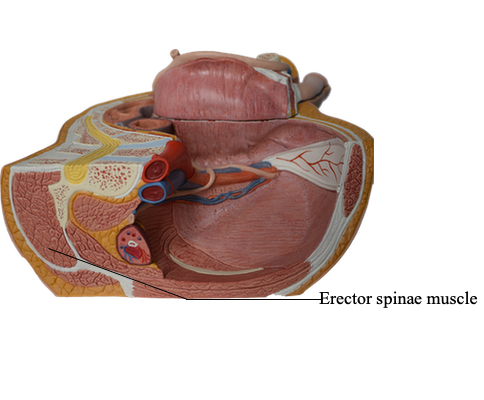Main Model

Erector spinae muscle

Intermediate Layer of Intrinsic Back Muscles
The massive erector spinae muscles lie in a “groove” on each side of the vertebral column between the spinous processes centrally and the angles of the ribs laterally. The erector spinae are the chief extensors of the vertebral column and are divided into three columns: The iliocostalis forms the lateral column, the longissimus forms the intermediate column, and the spinalis forms the medial column. Each column is divided regionally into three parts according to the superior attachments (e.g., iliocostalis lumborum, iliocostalis thoracis, and iliocostalis cervicis). The common origin of the three erector spinae columns is through a broad tendon that attaches inferiorly to the posterior part of the iliac crest, the posterior aspect of the sacrum, the sacro-iliac ligaments, and the sacral and inferior lumbar spinous processes.
The erector spinae are often referred to as the “long muscles” of the back. In general, they are dynamic (motion-producing) muscles, acting bilaterally to extend (straighten) the flexed trunk.
Erector spinae (Iliocostalis, Longissimus and Spinalis)
Proximal Attachment: Arises by a broad tendon from posterior part of iliac crest, posterior surface of sacrum, sacro-iliac ligaments, sacral and inferior lumbar spinous processes, and supraspinous ligament
Distal Attachment:
Iliocostalis: lumborum, thoracis, cervicis; fibers run superiorly to angles of lower ribs and cervical transverse processes
Longissimus: thoracis, cervicis, capitis; fibers run superiorly to ribs between tubercles and angles to transverse processes in thoracic and cervical regions, and to mastoid process of temporal bone
Spinalis: thoracis, cervicis, capitis; fibers run superiorly to spinous processes in the upper thoracic region and to cranium
Innervation: Posterior rami of spinal nerves
Main Action(s):
Acting bilaterally: extend vertebral column and head; as back is flexed, control movement via eccentric contraction
Acting unilaterally: laterally flex vertebral column